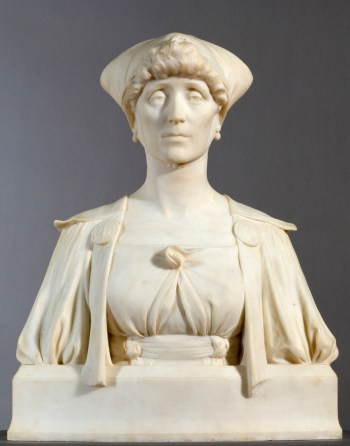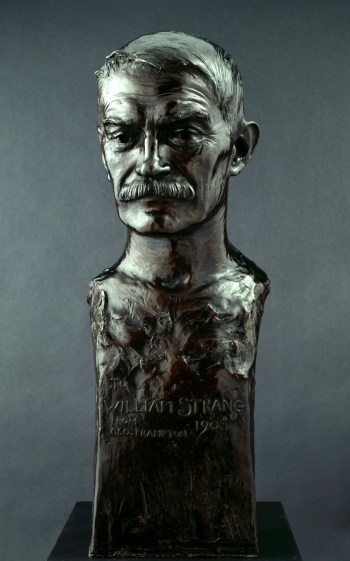Sir George Frampton RA (1860 - 1928)
RA Collection: People and Organisations
A key figure in the New Sculpture movement that championed dynamism and physical realism in sculpture, Sir George Frampton is best-known today for his statue of Peter Pan, installed in Kensington Gardens.
Frampton was born into a family of stone carvers. He initially worked in an architect’s office before deciding to follow his father’s profession. He studied sculpture at Lambeth School of Art and the Royal Academy Schools, where he met the artist Christine Cockerell. The two married in 1893 and their son, the painter Meredith Frampton, was born the following year. Frampton and Cockerell appear occasionally in each other’s art; she and Meredith modelled for his polychromatic Mother and Child sculpture, first exhibited at the 1895 Summer Exhibition.
Frampton’s reputation rose rapidly and he attracted early acclaim for his skilled use of many different materials, such as in his 1899 polychromatic bust, Lamia. Together with Lord Leighton, Sir Alfred Gilbert and Hamo Thornycroft, his work was seen as part of the “New Sculpture” movement and was characterised by a sense of dynamism and layers of rich symbolism. After Queen Victoria’s death in 1901, Frampton was commissioned to produce a bronze portrait bust to be installed in Calcutta and a full-length statue for memorials in Winnipeg, Merseyside and Leeds. He was elected a Royal Academician in 1904 and knighted two years later. Frampton enjoyed collaborating with architects and carried out decorative friezes for many public and private buildings, including Lloyd’s Registry of Shipping, London (1898- 1901).
In 1912, Frampton was commissioned by J.M. Barrie to produce a sculpture of Barrie’s beloved character Peter Pan, who had first appeared on the stage eight years earlier. Barrie saw the sculpture as a gift for the children of London, and took out an announcement in The Times on the morning of its installment, reading: “There is a surprise in store for the children who go to Kensington Gardens to feed the ducks in the Serpentine this morning … a May-day gift by Mr J M Barrie, a figure of Peter Pan blowing his pipe on the stump of a tree.” However, the author was reportedly less than pleased with the statue himself, unhappy that Frampton had chosen his own model rather than using photographs of Michael Llewelyn-Davies, one of Barrie’s own inspirations for the character.
During the First World War, Frampton’s anti-German feelings ran so high that he argued passionately for all artists he considered “enemy aliens” to be expelled from the many artistic societies he was involved with, including the Art-Workers Guild. In protest at the defeat of his motion to expel Karl Krall, a German-born British citizen, from the latter, Frampton himself resigned and demanded that his name be stricken from all records, although Krall was so discomfited by the controversy that he also voluntarily left the Guild.
Frampton died in 1928 and his son Meredith took over his studio. Two years later, a memorial to him was installed in St Paul’s Cathedral, showing a child holding a miniature version of Frampton’s beloved Peter Pan.
Profile
Born: 18 June 1860 in London, England, United Kingdom
Died: 21 May 1928
Nationality: British
RA Schools student from 7 March 1882
Elected ARA: 9 January 1894
Elected RA: 26 March 1902
Gender: Male
Preferred media: Sculpture
Works by Sir George Frampton in the RA Collection
3 results
Associated archives
17 results
-
George Frampton, 90 Carlton Hill, St. John's Wood, to [W.T. Whitley]
20 Sep 1909
Item WTW/15
-
Albert Toft, The Studio, 223 Portsdown Road, Maida Vale, to Spielmann
15 Jan 1935
File SP/19/10
-
George Frampton, 90 Carlton Hill, St. John's Wood, to Spielmann
7 Oct 1914
Item SP/15/1
-
Earl of Crawford, 7 Audley Square, to S[pielmann], Uplands, Folkestone
7 Oct 1924
Item SP/9/12


